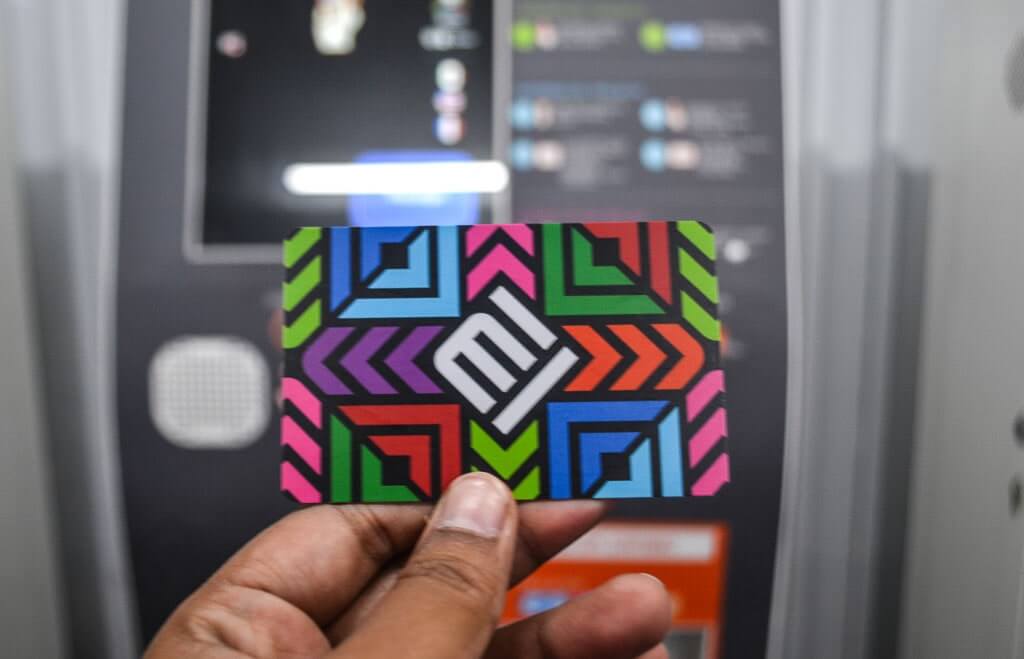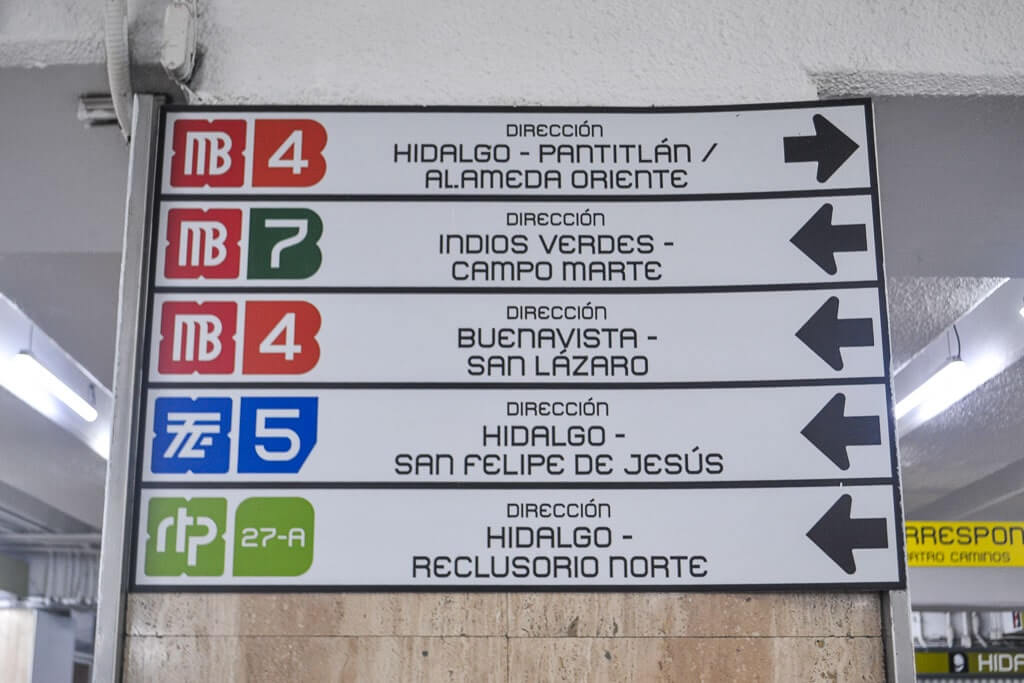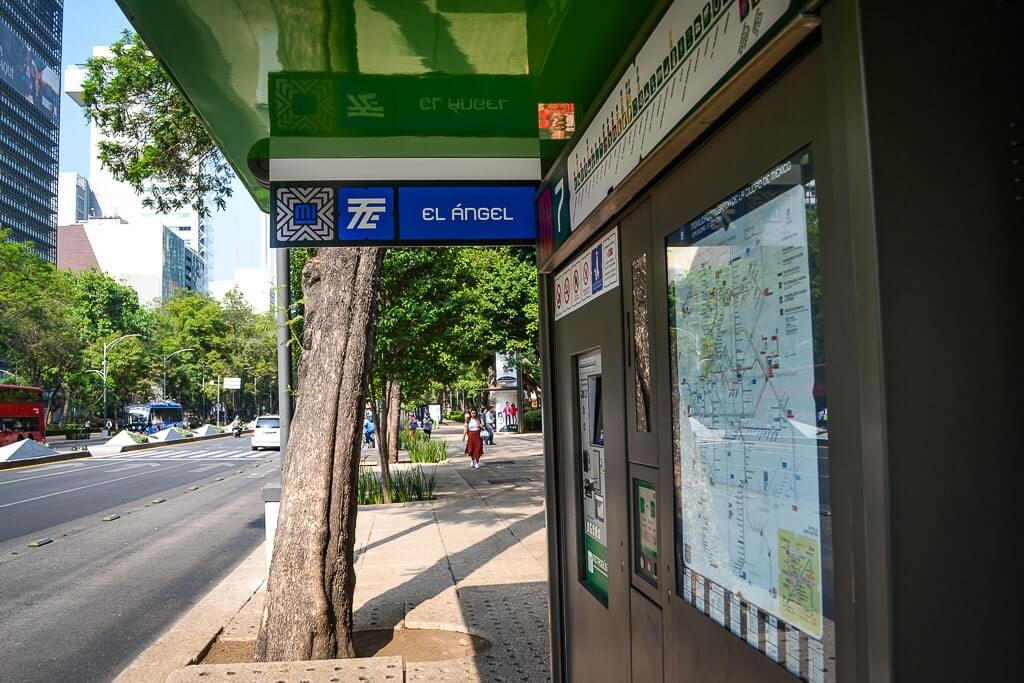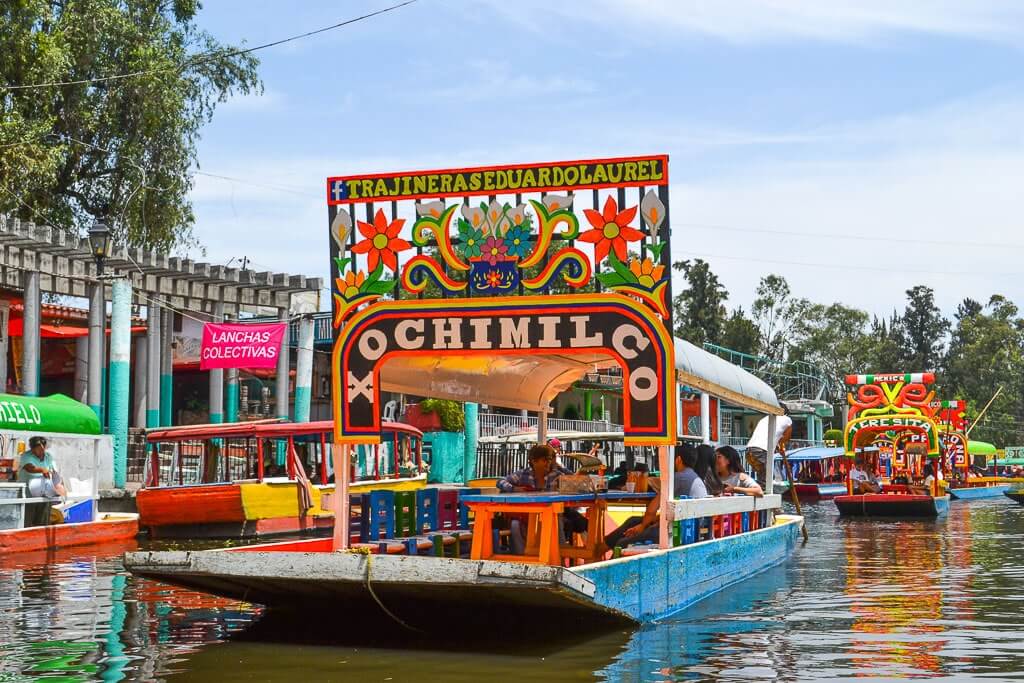Last Updated on January 21, 2024 by Soumya
Are you looking for the best way to get around Mexico City as a tourist? Short Answer – Use Public Transportation.
Mexico City has an extensive public transport system consisting of metro, buses, microbuses, suburban trains, intercity buses, and many more.
The city is large and, well, a little chaotic. Mexico City traffic is really really bad. So, if you wish to get anywhere in Mexico City on time, public transportation is your best bet.
Here are my top 2 tips for using Mexico City public transportation.
- Buy a Mexico City Metro Card. You can use it on the metro, the light rail, the Metrobus, and so much more.
- Avoid rush hours or the infamous hora pico. Take a taxi instead to preserve your sanity. Uber and DiDi are my favorites.
- If you’re visiting Mexico City for a day or two, stay in the historic center and save time on commute.
Please note: This post may contain affiliate links which means I may earn a commission if you make a purchase by clicking a link on this post. This will be at no additional cost to you. Affiliate links help me keep this website up and running. Thanks for your support!
Mexico City Metro Card
Now let’s dig into the mindblowing expanse of Mexico City Public Transportation. But before that, something more important – MEXICO CITY METRO CARD.

The Mexico City Metro Card, known locally as “Tarjeta del Metro” and officially as the “Integrated Mobility Card”, serves as a universal ticket across most public transportation in Mexico City.
This rechargeable (and colorful) card is an efficient way to pay for your trips on the Metro, Metrobus, Tren Ligero, Cablebus, and even some city buses. You can also pay for Ecobici public bicycles with this card.
Where to buy a Metro Card in Mexico City?
Purchase the Metro Card at any Metro station for a minimal fee of 15 pesos (under $1 US). It can be topped up with any amount at any of the card machines in the Metro or Metrobus stations.
To use it, simply tap it at the turnstile when entering a Metro station or bus.
I have visited Mexico City several times and also lived there. Every single time, the Metro Card has been my trustworthy companion.
Trust me, you’re going to need a Metro Card if getting around in Mexico City by public transportation is on your mind.
✦ Pro Tip: Please note that individual paper tickets are no longer sold. That makes the Metro Card an absolute necessity for using Mexico City public transportation system.
Types of Mexico City Public Transportation
Mexico City Metro
Mexico City Metro system is one of the most extensive and busiest in the world. It is an excellent way to navigate the sprawling metropolis.

With 12 lines that cover a significant portion of the city, the Metro in Mexico City is affordable, convenient, and easy to understand.
Each line has a number and color associated with it. For example, Line 2 is also called the Blue Line.
There are nearly 200 metro stations in Mexico City. Good news? You do not need to know all of them!
Some of the important metro stations are Zocalo, Bellas Artes, Hidalgo, and Tasquena.
In my opinion, the best way to get around the metro is by installing the Mapaway App on your phone. Once you input your departure and arrival points, the app gives you exactly what metro lines to take and where to change.
You can also download a copy of the Mexico City Subway Map on their official website here.
Fare
With a fare of just 5 pesos (about $0.25 US) per ride, the metro is undoubtedly one of the cheapest methods of public transportation in Mexico City.
Hours
Weekdays – 5:00 am – midnight, Saturday – 6:00 am – midnight, and Sunday – 7:00 am – midnight.

Do I recommend Mexico City Metro?
Yes, I absolutely do.
I have taken several rides on the Mexico City metro including many on Line 2 or the Blue Line which takes you all the way to Zocalo in the Historic Center and one really uncomfortable one on Line 3 (it was right in the middle of rush hour and we should have planned our day better).
By far, the Metro is my favorite means of public transportation in Mexico City. It scores super high because it is cheap, well-connected, timely, and convenient.
Plus, I always feel quite safe in the metro contrary to what you might have heard elsewhere on the internet.
✦ Pro Tip: Mexico City metro trains get quite crowded during rush hours. Rush hour, locally known as hora pico is usually between 8:00 am – 10:00am and 6:00 pm – 9:00 pm. I try and avoid them like plague.
Mexico City Metrobus
Mexico City Metrobus is an efficient way to navigate the city.
These red buses operate on dedicated lanes. Therefore, they provide smooth and fast service, often outrunning Mexico City’s notorious traffic.
The Metrobus has 7 lines running through major avenues, ensuring broad coverage of the city.

To get around Mexico City as a tourist, you only need to know about 2 Metrobus lines – Line 4 and Line 7.
Line 4 covers Zocalo and Bellas Artes in downtown Mexico City. Line 7 covers Paseo de la Reforma, Chapultepec, and the Plaza of Three Cultures (an interesting Aztec ruin in Mexico City).
Find more details about Metrobus on their official website here.
Fare
The fare at 6 pesos (approximately $0.30 US) is slightly higher than the Metro but still very affordable.
You need to tap the Metro Card to get onto the bus boarding platform. For smaller bus stops that do not have a platform, you can tap the card inside the bus.
Hours
Mexico City metrobuses operate from 4:30 am – 12:00am during weekdays and Saturdays and from 5:00 am – 12:00 am on Sundays.
The buses are spacious and well-maintained, but equally crowded as the Metro, particularly during rush hours.

Do I recommend Mexico City Metrobus?
Yes, I do. But I recommend the metro more.
Only one place where the Metrobus scores higher than the Metro is in the views that you get while riding it. You can see a fair bit of Mexico City from the Metrobus, provided you get a window seat.
One of my favorite Metrobus lines that we regularly used while living in Mexico City was Line 7 that operates between Indios Verde and Campo Marte. Line 7 passes through many important Mexico City landmarks including El Angel, La Diana, Chapultepec, and Anthropologia.
The best part about Metrobus Line 7 is that it operates double-decker buses. Be sure to get a seat on the upper level and enjoy the views that come with it.
Microbuses and Combis
Combis and microbuses are smaller buses that serve lesser-known routes in Mexico City.
A combi is smaller than a microbus. You can actually think of it as the collectivo in the Yucatan Peninsula. Collectivos are, in fact, a popular way of traveling from Valladolid to Chichen Itza.

Microbuses aren’t very expensive and help you get to places that the Metrobuses and Metro cannot reach. For example, we used both combis and microbuses extensively when commuting between Coyoacan and San Angel neighborhoods.
Most minibuses accept cash payment. Some may accept the Mexico City Metro Card.
Tren Ligero (Light Rail) in Mexico City
Tren Ligero, or Light Rail, is another efficient mode of public transport in Mexico City.
The Light Rail is particularly useful for tourists in Mexico City because it provides easy access to several tourist attractions in the southern part of CDMX. This includes the Coyoacan district, the Frida Kahlo Museum, and the Xochimilco Floating Gardens.
The train runs from the Tasquena terminal in Mexico City to Xochimilco.

Fare
The fare is 3 pesos ($0.15 US) which you can pay by using your Metro Card.
Hours
The Light Rail operates from 5:00 am – 12:00 am on weekdays, 6:00 am – 12:00 am on Saturdays, and 7:00 am – 12:00 am on Sundays. Find more details on the official website here.
Ecobici Public Bicycles
Looking for a more sustainable public transport option in Mexico City? Try Ecobici Public Bicycles.
These bikes are found throughout the city, with over 650 stations and 9,000 bikes available.
They’re perfect for short trips or for exploring the city at a leisurely pace.

How to rent an Ecobici bike?
Renting an Ecobici bike is pretty straightforward.
First, you need to sign up and create an account on their website. Or download their app and create an account.
Then, you need to buy an Ecobici subscription. Subscriptions for 1-day, 3-days, 7-days, and for the entire year are available.
The 1-day subscription costs around 118 pesos and the annual plan is around 521 pesos. Find more about the subscriptions on the Ecobici official website here.
Pay for your subscription using a credit or debit card. I have heard that you can pay with your Metro Card too if you register at one of their service centers.
How to use Ecobici bikes?
Once you have purchased a subscription, you can use the bikes for 45 minutes at a time without incurring any additional fees.
If you need to use the bike for longer, there are additional charges. Or simply return the bike to any station and check out another one.
Ecobici bikes in Mexico City are available from 5:00 am – 12:30 am throughout the week.
Stations are conveniently located throughout the city, making Ecobici a flexible and convenient choice for navigating Mexico City.
Suburban Trains in Mexico City
Mexico City has an efficient suburban train system, known as the “Tren Suburbano” or Ferrocarriles Suburbanos.
Tren Suburbano has only one line that runs from Buenavista station in Mexico City to Cuautitlan in the State of Mexico. There are several stops along the way including Tlalnepantla, Tultitlan, and Lecheria.
The suburban train is a great way to see some historic places right outside Mexico City especially some of Mexico’s hidden gems.
I took Tren Suburbano from Cuatitlan to Buenavista while returning from my visit to Tepotzotlan. It was a smooth ride of about 50 minutes.
However, what really impressed me was the huge train station at Cuatitlan and the shops and facilities there. There was a huge bakery at Cuatitlan from where I picked up some of my favorite Mexican bread.

Fare
The fare for the suburban train ranges between 10-23 pesos ($0.6 – $1.5 US) per trip.
But remember that you cannot use the Mexico City Metro Card to pay for a trip on Tren Suburbano.
You have to purchase a rechargeable Suburban Card for 16 pesos ($0.75 US) and top it as you go.
Given that you may use this card only for one trip, it doesn’t make a lot of sense to buy it. Take an intercity bus from Mexico City to Tepotzotlan, instead.
Hours
Mexico City’s suburban trains operate from 5:00 am to midnight on weekdays, and from 6:00 am to midnight on weekends.
Frequency is 8-15 mins, depending on the time of the day. You may find the detailed train schedule on Tren Suburbano official website here.
Hop-on Hop-off Mexico City Buses
Two companies operate hop-on hop-off buses in Mexico City – Turibus and Capital Bus.
These double-decker buses cover a variety of routes, taking you to some of the city’s most popular attractions, including the Historic Center, Polanco, and Condesa-Roma.

To be specific, Capital Bus runs in 3 different routes – Downtown to Polanco, Downtown to Coyoacan, and on a Temples of History trail. Find all the details here.
Turibus, on the other hand, operates in 4 different circuits – Historic Center, Polanco, Coyoacan, and Basilica. Find the details here.
If you’re visiting Mexico City for a day or a short layover, riding a hop-on hop-off Mexico City bus is an incredible way to get a comprehensive overview of the city.
Tickets and Hours
Be sure to book your Mexico City hop-on hop-off bus tickets in advance to reserve your spot.
↳Click here to book your ride on Turibus Mexico City.
↳Click here to book your ride on Capital Bus Mexico City.
Remember that the buses run from 9:00 am to 7:00 pm every day, with buses arriving at each stop approximately every 30 minutes.
Cable Bus
The Cable Bus is an aerial cable car that provides a bird’s eye view of Mexico City.
It currently consists of two lines, Line 1 and Line 2, which connect Cuautepec to Indios Verdes and over Iztapalapa district, respectively. Cable Bus Line 2 has views to die for.
Even though the Cable Bus was built for transporting locals in Mexico City, it is a beautiful (and secret) tourist attraction.
Tickets
To ride the Mexico City Cable Bus, purchase a ticket (7 pesos) from the booth and hop on.
You can also book yourself a 5-star cable car tour like this one and enjoy the tour with a knowledgeable tour guide. The tour also takes you to some really non-touristy places in Mexico City such as the Iztapalapa Museum and the Quetzalcoatl Market.

Mexico City Intercity Buses
Intercity buses are an efficient and popular mode of public transportation not just in Mexico City but all of Mexico. They connect to various parts of Mexico, providing an economical and comfortable way to travel long distances.
Some of the popular destinations that you can get to by intercity buses from Mexico City include the Pyramids of Teotihuacan, San Miguel de Allende, Guadalajara, Acapulco, Tula, and Puebla. That’s why they are super helpful in planning the best Mexico City day trips.
Traveling on an intercity bus is one of my favorite ways to get around Mexico. I have used them so many times that I have lost count.
These how-to guides will definitely help you plan some great side trips from Mexico City.t

4 Main Intercity Bus Stations in Mexico City
- Centro de Autobuses del Norte serves destinations to the north. Buses for the ancient pyramids of Teotihuacan and Tula, San Miguel de Allende depart from here.
- Terminal de Autobuses de Pasajeros de Oriente (TAPO for short) for routes to the east such as Puebla, Chiapas, Veracruz, and Yucatan.
- Terminal Central del Sur Taxquena serves southern destinations such as Cuernavaca, Morelos, and Acapulco.
- Central de Poniente serves western routes. Buses for Oaxaca, Michoacan, and Queretaro depart from here.
Most bus terminals in Mexico City offer facilities such as restrooms, eateries, and waiting areas.
Best Bus Lines in Mexico
Popular intercity buses from Mexico City include ADO (they have some of the best buses in the country), Autobuses Teotihuacan, Estrella Roja, Pullman de Morelos, Estrella de Oro, and ETN (most luxurious buses).
Remember to check bus schedules and book your tickets in advance. Some routes like the buses from Mexico City to Puebla, Oaxaca, and San Miguel de Allende are extremely popular and tickets get sold out pretty fast.
One of the most reliable platforms that I regularly use to book my ADO buses in Mexico is Busbud. Their interface is user-friendly and it is very convenient to have all my tickets in one place.

Other types of Mexico City Transport
Taxi Service in Mexico City
If you’re not really keen about traveling by public transport in Mexico City, then you can always opt for taxis.
Traditional taxis, easily distinguishable by their pink and white color, can be found at every corner. Always opt for ‘sitio’ taxis (taxi stands), which are considered safer.
Or use a popular ride-sharing app like Uber or DiDi which are the safest taxi services in Mexico City. We used both Uber and DiDi several times during our stay in Mexico City and found them to be affordable and convenient.
However, if you’re looking for a taxi to take you to your hotel from the Mexico City Airport, then I highly recommend booking a reliable private transfer like this one. This airport transfer has over 90 5-star reviews and comes with the best chauffeur and the cleanest car. ↳Click here to book your Mexico City airport transfer.
Guided Tours
Guided tours are another popular way of getting around Mexico City especially if want to reach places that are relatively further away such as Xochimilco, Teotihuacan, Puebla, and San Miguel de Allende.

Here are some of the best guided tours that include round-trip transportation from Mexico City.
By booking a guided tour, you ensure that you have a relaxing vacation and don’t spend way too much time figuring out how to get from one place to another.
Mexico City Public Transportation FAQ
No, the Mexico City Metro is not free to use. A single ride on the Mexico City Metro costs about 5 pesos ($0.25 US) and you need to buy a Metro Card (worth 15 pesos ($1 US) that you can top up as you go) to use the subway.
Buy a Mexico City Metro Card and pay for the Metrobus fare by tapping the metro card inside the bus or at the turnstile at the bus boarding platform.
Yes, there is an extensive metro system in Mexico City that covers a large part of the city with 12 metro lines and more than 200 metro stations.
A metro ticket in Mexico City costs 5 pesos ($0.25 US).
The cheapest way to get around Mexico City is by metro and Metrobus. A single ride on the metro costs 5 pesos ($0.25 US) and on the Metrobus costs 6 pesos ($0.3 US).
Yes, I use Mapway app for Mexico City Metro which I find to be very convenient and easy to use. Just enter your departure and arrival points and the app gives you the best route to get there.
Technically, yes, you can take luggage on the Mexico City Metro. But the metro trains are usually crowded, more so during the rush hours. So, be mindful of other passengers and be sure not to discomfort them.
The safest way to get around Mexico City is by Uber and DiDi, the two best ride-sharing apps in town.
Found this Mexico City Public Transportation guide useful? Pin it for later!


